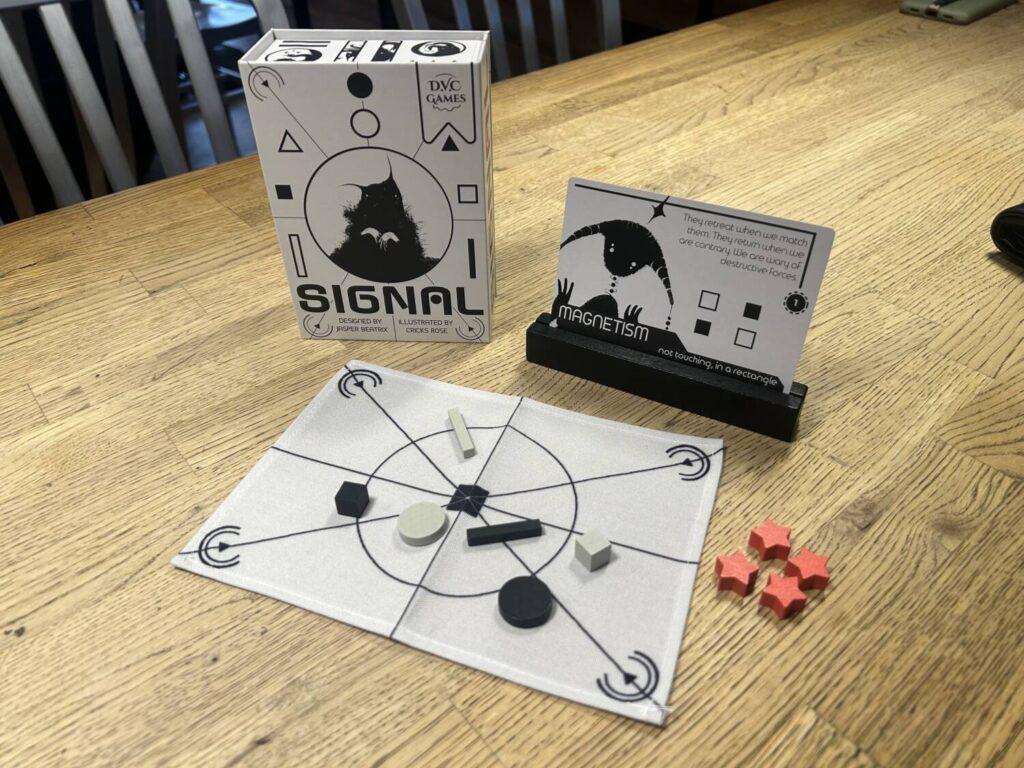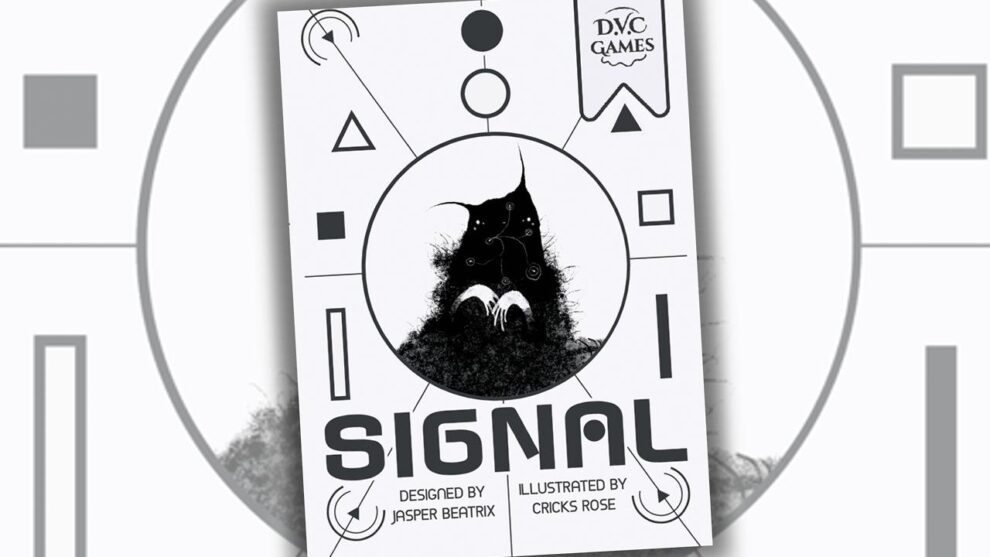Disclosure: Meeple Mountain received a free copy of this product in exchange for an honest, unbiased review. This review is not intended to be an endorsement.
Signal is a quiet, cerebral cooperative puzzle, a meditation on communication that is nowhere near as precious as the phrase “a meditation on communication” may imply. Players work together to communicate with an alien, represented by an evocative black-and-white illustration on a card and embodied by a lone, silent player. The Terrans send signals, rods and cubes and circles and triangles in black and white arranged on a cloth board. Most of the playtime is spent arranging these signals.
When a signal is ready, the alien responds by changing it. Maybe he/she/it/they shift some pieces around, or remove some pieces. They might create a stack, or swap pieces. It could be, and often is, some combination of things. The hope is that the alien will send back the exact signal shown on the front of their card. Nothing more, and nothing less.
Whatever the alien does, they’re following the rules laid out on the back of their card. “Place a black rod on a black disc,” for example, or, “Remove two rods and place a different shape in between where they were.” If the first round of communication is successful within ten attempts, everyone moves on to the second round. The goal doesn’t change, but an additional set of rules are added, which are performed after the first set of rules. A third round awaits on the other side of the second if you figure it out.
 Trying to crack the alien’s code is tremendous fun, particularly when your efforts keep just missing the mark. The rules themselves are never baroque. They are instead designed to interact in clever ways. A second round rule forces you to step back and think about the first round rule in a different way. I don’t really enjoy playing games that involve blind, fumbling guesses, and I loved my first time stepping away from the alien role in Signal. I find myself mourning the future in which I don’t get to do that anymore, since you can’t play opposite the same alien more than once, and you can never do so with an alien you’ve embodied.
Trying to crack the alien’s code is tremendous fun, particularly when your efforts keep just missing the mark. The rules themselves are never baroque. They are instead designed to interact in clever ways. A second round rule forces you to step back and think about the first round rule in a different way. I don’t really enjoy playing games that involve blind, fumbling guesses, and I loved my first time stepping away from the alien role in Signal. I find myself mourning the future in which I don’t get to do that anymore, since you can’t play opposite the same alien more than once, and you can never do so with an alien you’ve embodied.
There’s always the concern with these kinds of games that being the odd role out will be thankless. You sit there silently while everyone else talks, then follow a conversion algorithm while they watch. That doesn’t sound fun. Fortunately, though the role of the alien won’t appeal to everyone, Signal avoids that problem. The instructions leave space for creativity, for a stubborn insistence that you can make this one work. There’s also room for thinking on your toes. If your teammates are caught on a particular step of the instructions, if they keep making the same mistake, you can try to follow it in a way that might shake things up.
There’s something anthropological about being the alien. I watch the humans with joy and fascination. Because the game allows for genuine exploration, you learn things about people as individuals and people as a whole through how they play. Some people wing it. One friend made his initial guess by picking up some pieces, shaking them around in his hand, and then casting them out onto the cloth, ready to read the bones. Another friend has become absolutely certain, every time, that the rule has something to do with symmetry. Groups and individuals would get hung up on ephemera, interpreting noise for the signal.
Every now and then, following the noise actually works. “He’s only removing pieces that he can see from above” when the real reason is both unrelated and mutually inclusive. That relative lack of rigor—I promise, the aliens are plenty exacting—may rub puzzle freaks the wrong way, but it speaks to the larger point of this wonderful exercise. The goal of Signal isn’t to articulate the rules, nor to completely understand why what you’re doing works. The goal is to successfully communicate. Communication is imperfect. You can’t always say exactly what you want to, or what you mean to. That doesn’t mean you won’t manage to reach a mutual understanding.











Add Comment